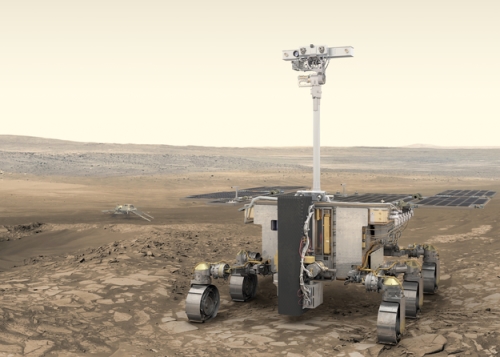A laser module that will be used to analyse organic matter on Mars as part of a European-Russian space mission, has been delivered to the NASA Goddard Space Flight Center by the Laser Zentrum Hannover.

Artist's impression of the ExoMars rover and surface platform on the surface of Mars. Image: ESA/ATG medialab
The rocket of the European-Russian ExoMars mission will start its nine-month journey to Mars in 2020, together with a rover and surface platform, with the major goal of searching for past or present life on the planet.
The ExoMars rover will travel over Mars' surface and analyse organic matter, such as molecules in the soil, which could provide clues to possible forms of life. The rover will contain the Mars Organic Molecule Analyser (MOMA), containing the laser delivered by the LZH, which will make up part of the Laser Desorption Mass Spectrometer (LD-MS).
The MOMA module is being developed by the LZH and partners under the leadership of the Max Planck Institute for Solar System Research (MPS) located in Göttingen, Germany.
Robust laser optics
In the past few years, the LZH has developed the diode-pumped solid-state laser head in the UV spectral range required for the investigations. The laser has an emission wavelength of 266nm and an adjustable laser pulse energy of up to 130μJ. Its most important unique features, however, are its low weight at 220g, and small size at about 20cm in length. In addition, the laser head has to be robust enough to function on Mars, withstanding mechanical shocks during take-off and landing, as well as undergoing huge temperature variations. Moreover, the laser optics must withstand both the UV radiation of the laser and the ionising effects of cosmic radiation. The optics with space-qualified optical coatings were provided by German manufacturer Laseroptik and evaluated at the LZH.
'The laser is optimally adapted to the harsh environmental conditions in space and its mission on Mars,' explained Dr Peter Weßels, head of the solid-state lasers group at the LZH. 'We use a passively Q-switched Nd:YAG oscillator pumped longitudinally over an optical fibre. The infrared light of the oscillator is converted into ultraviolet radiation using nonlinear crystals. A temperature control is [used] to ensure the function even with changing ambient temperature and also allows the flexible adjustment of the output pulse energy.'
Before delivery of the model aircraft to NASA, the laser head was thoroughly tested at the MPS in Göttingen. Currently, it is being integrated into the mass spectrometer at the Goddard Space Flight Center and tested again. It then has to pass environmental tests again with NASA's mass spectrometer before being re-integrated into the Rover back in Europe.
The project is being funded by the Space Agency of the German Aerospace Center with funds from the Federal Ministry of Economics and Technology.
NASA's mission to Mars in 2020 will also employ a laser spectroscopy system, developed by the Centre National d’Etudes Spatiales (CNES), the Research Institute in Astrophysics and Planetology (IRAP), and electrical engineering giant Thales Group. The laser system, known as SuperCam, will be integrated onto NASA’s Mars 2020 rover
SuperCam will serve as the next generation of the ChemCam spectroscopy system currently aboard the Curiosity rover, which has been on Mars since August 2012. ChemCam features the most powerful laser to operate on the surface of another planet, and uses it to perform laser induced breakdown spectroscopy (LIBS), a process where infrared pulses a few billionths of a second in duration are used to vaporise samples of matter at temperatures exceeding 8,000°C, the chemical signature of which is then captured in spectral images.
The SuperCam will be able to switch between using a new, faster LIBS system and a non-destructive Raman spectroscopy system that uses an entirely new conduction-cooled laser. While the LIBS system uses a 1,064nm wavelength, the Raman system features a KTP crystal that halves the same wavelength to 532nm, allowing it to detect the molecular structures of organic matter, revealing evidence of past life.

